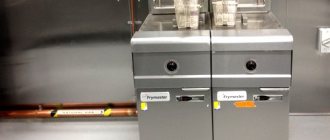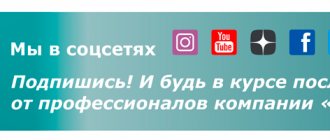In 2020, new sanitary requirements were introduced for physical factors in the workplace, microclimate, lighting, noise levels, vibration and other important points, as well as requirements for the organization of control, methods for measuring physical factors and measures to prevent their harmful effects on the health of workers. All (with some exceptions[1]) entrepreneurs and legal entities are required to comply with these rules.
Let's look at the most important points.
Sanitary and epidemiological requirements for physical factors in workplaces (SanPiN 2.2.4.3359-16), approved by Resolution of the Chief State Sanitary Doctor of the Russian Federation dated June 21, 2016 No. 81 (hereinafter referred to as SanPiN 2.2.4.3359-16, Rules), came into force on 1 January 2020. At the same time, from this date the following were declared invalid:
- SanPiN 2.2.4.1191-03 “Electromagnetic fields in industrial conditions” (put into effect by Resolution of the Chief State Sanitary Doctor of the Russian Federation dated February 19, 2003 No. 10);
- Appendix 3 to the hygienic requirements for personal electronic computers and work organization (SanPiN 2.2.2/2.4.1340-03; put into effect by Resolution of the Chief State Sanitary Doctor of the Russian Federation dated 06/03/2003 No. 118).
Regarding the effective date of SanPiN 2.2.4.3359-16, we note the following.
There is a draft Resolution of the Chief State Sanitary Doctor of the Russian Federation “On amendments to the Resolution of the Chief State Sanitary Doctor of the Russian Federation dated June 21, 2016 No. 81 “On approval of SanPiN 2.2.4.3359-16 “Sanitary and epidemiological requirements for physical factors in the workplace” (posted on the website https://regulation.gov.ru).
One of the changes concerned the date of entry into force of sanitary rules. It was planned that SanPiN 2.2.4.3359-16 would come into force not from 01/01/2017, but from 03/01/2017.
However, the amendments are still undergoing approval stages. At one of these stages (03/07/2017), the Ministry of Economic Development of Russia gave a negative opinion on this project, concluding that it contains provisions that introduce excessive administrative and other restrictions and obligations for business entities and other activities or contribute to their introduction, contributing to the emergence of unreasonable expenses of business entities and other activities, the occurrence of unreasonable expenses of budgets of all levels of the budget system of the Russian Federation. Comments were also made regarding the already adopted document SanPiN 2.2.4.3359-16.
At the time of preparation of the article, there was no information about the finalization of the project by Rospotrebnadzor taking into account the comments. Accordingly, sanitary rules came into force at the beginning of this year.
Application of sanitary rules
As mentioned above, citizens in employment relationships, individual entrepreneurs and legal entities are required to comply with these requirements (clause 1.2 of SanPiN 2.2.4.3359-16).
They apply to facilities being designed, newly put into operation, reconstructed and in operation from the moment SanPiN 2.2.4.3359-16 comes into force (clause 1.6).
The Rules are applied when assessing the levels of occupational health risks of workers and developing preventive measures (clause 1.9 of SanPiN 2.2.4.3359-16).
Who sets sanitary standards and rules?
In general, the issuance of sanitary requirements and standards is the responsibility of the chief sanitary doctor of the Russian Federation . For example, sanitary and epidemiological rules and regulations (SanPiN) are put into effect by its regulations.
In the context of measures to counter the pandemic, various structures may introduce additional requirements. For example, the Ministry of Health and the chief sanitary doctor give recommendations on coronavirus, which are enshrined in regional law. They become mandatory in the region.
Explanations on the application of new norms and rules are most often provided by Rospotrebnadzor . By the way, he also controls the implementation of many of them.
The questions are further explained based on the explanations that Rospotrebnadzor and the Ministry of Health actively provide.
The general procedure for employers to comply with new sanitary standards is described in our material “What Rospotrebnadzor recommended to employers for the prevention of coronavirus .
https://youtu.be/2cUEhHy3HFw
Microclimate at work places
The microclimate in the workplace must ensure the preservation of the thermal balance of a person with the environment and the maintenance of an optimal or acceptable thermal state of the body (clause 2.1.1 of SanPiN 2.2.4.3359-16).
Indicators of the microclimate of workplaces in industrial premises are established taking into account the total energy consumption of workers, the duration of work, periods of the year and include requirements for methods of measuring and monitoring the body (clause 2.1.3 of SanPiN 2.2.4.3359-16).
Based on the body's total energy expenditure in Watts (W), jobs are classified into categories. Characteristics of individual categories of work are presented in Appendix 1 to SanPiN 2.2.4.3359-16.
Microclimate indicators are standardized for periods of the year (clause 2.1.5, 2.1.6 SanPiN 2.2.4.3359-16) - warm, when the average daily air temperature according to the hydrometeorological service is above +10 °C, and cold - +10 °C and below).
The microclimate in workplaces located in open areas in various climatic zones (regions) of the Russian Federation is assessed in accordance with Appendix 5 to the Rules (clause 2.1.8 of SanPiN 2.2.4.3359-16[2]).
Optimal microclimatic conditions are established according to the criteria for the optimal thermal state of a person dressed in a set of clothes with thermal insulation of 1 clo in the cold season and 0.7–0.8 clo in the warm season (clause 2.2.2 of SanPiN 2.2.4.3359-16). The optimal values of microclimate parameters at workplaces for work of different categories are given in Table. 2.1 SanPiN 2.2.4.3359-16 (clause 2.2.4).
Acceptable microclimatic conditions are established according to the criteria for the permissible thermal state of a person dressed in a set of clothes with thermal insulation of 1 klo in the cold season and 0.7–0.8 klo in the warm season, for an 8-hour work shift (clause 2.2.3 of SanPiN 2.2 .4.3359-16). They do not cause health problems, but can lead to a feeling of thermal discomfort, deterioration of well-being and decreased performance. The permissible values of microclimate parameters at workplaces are given in table. 2.2 SanPiN 2.2.4.3359-16 (clause 2.2.6).
Note!
If, due to technological requirements for the production process, it is impossible to establish acceptable standard values for microclimate parameters, microclimate conditions are considered harmful and dangerous (clause 2.2.14 of SanPiN 2.2.4.3359-16).
In this case, protective measures must be used to normalize the thermal state of the worker’s body (working clothing, personal protective equipment, rest rooms with standardized microclimate parameters, regulation of the time of continuous stay in an unfavorable microclimate).
The assessment of the combined impact of microclimate parameters for the implementation of measures to protect workers from possible overheating is carried out using the THC index, the standard values of which are given in Table. 2.4, and the algorithm for determining it is in Appendix 2 to SanPiN 2.2.4.3359-16 (clause 2.2.15).
If the air temperature in the workplace is higher or lower than permissible values, the duration of work within the work shift is set in accordance with Appendix 3 to the Rules (clause 2.2.16).
For industrial premises equipped with artificial cooling or radiant heating systems, sanitary and epidemiological requirements for microclimate parameters are given in Appendix 4 to SanPiN 2.2.4.3359-16 (clause 2.2.17).
Microclimate parameters, in order to monitor their compliance with sanitary and epidemiological requirements, are measured as part of production control at least once a year: in the cold season - at an outside air temperature not higher than –5 °C, in the warm season - not lower than 15 °C [3]) (clause 2.3.1 SanPiN 2.2.4.3359-16).
The parameters are assessed based on the arithmetic mean values of three measurements, which should not exceed the regulatory requirements established by this SanPiN.
For your information
Parameters are measured at workplaces, and if the workplace is several areas of the production premises - at each of them (clause 2.3.3 of SanPiN 2.2.4.3359-16).
Measurement and evaluation of its results are carried out in accordance with table. 2.5, 2.1, 2.2, as well as clauses 2.3.5–2.3.8 of the Rules.
What requirements must an employee’s workplace meet?
Occupational safety is a primary requirement!
The most important requirement when organizing a workplace is to ensure safe, comfortable working conditions and to prevent the occurrence of occupational diseases and accidents.
This entire set of measures is called occupational safety and health. In other words, labor protection, in essence, is a system of legislative acts in conjunction with socio-economic, organizational, technical, hygienic, therapeutic and preventive measures and means that ensure safe working conditions and the preservation of the health of enterprise employees.
To do this, it is necessary to create favorable working conditions in accordance with sanitary standards, safety regulations, ergonomics, and aesthetics.
Indoor microclimate
The legislation of our country strictly regulates the temperature and humidity of indoor air. In particular, when the average daily temperature outside is below 10°C, the amplitude of its fluctuations indoors should be 22-24°C. When the ambient temperature is higher than the specified value - 23-25°C. In case of temporary non-compliance with these conditions in one direction or another, the length of the working day is reduced (SanPiN 2.2.4.3359-16 dated June 21, 2020 No. 81).
Protection from the harmful effects of computer technology
Since today it is impossible to imagine office work without a PC, there are standards for employees who use computer equipment in their work. For example, when working with a computer with a flat-panel monitor, the workplace must have an area of at least 4.5 square meters. m, when using a kinescope monitor - 6 sq.m. After each hour of operation, the room must be ventilated (SanPiN 2.2.2/2.4.1340-03 dated May 30, 2003). The same regulatory act regulates the height, width and depth of the feet under the desk, and stipulates the mandatory presence of a footrest with a corrugated surface.
The level of electrostatic and electromagnetic fields, radiation and ultraviolet radiation, radio frequency ranges and other factors harmful to the health of employees are also regulated.
Attention! The use of copiers, printers and other office equipment is prohibited in basements, and for ordinary offices, appropriate standards for the distance between technical equipment have been established (SanPin 2.2.2. 1332-03).
Lighting requirements
Also, the relevant articles of SanPin establish standards for lighting. For example, the illumination in the room should be between 300 and 500 lux. When using artificial lighting, lighting parameters must ensure good visibility of the information displayed on the personal computer screen. For local lighting, lamps installed on work tables or specially equipped panels for vertical installation are recommended (SanPiN 2.2.1/2.1.1.).
Noise requirements
The maximum threshold for noise level is 80 decibels (SanPin 2.2.4. 3359-16). Regulatory documents provide for the installation of special foundations or shock-absorbing pads under the main noise-producing equipment and other equipment, as well as the use of noise-absorbing materials.
Providing conditions for eating
The procedure for eating at the workplace is regulated by Article 108 of the Labor Code of the Russian Federation, SNiP 2.09.04-87:
- if the number of employees is less than 10 people, a space of at least 6 square meters is required. m, equipped with a dining table;
- with up to 29 employees, the required area is twice as large;
- if the enterprise employs up to 200 employees, it is obligatory to have a canteen-serving area;
- if the number of employees exceeds 200, the canteen must be provided with raw materials or semi-finished products.
Unregulated situations
If situations arise that are not regulated by sanitary and hygienic standards (the roof is leaking, the toilet is faulty, etc.), the employee has the right to refuse work. In this case, the employer is obliged to offer him other employment until the problem is completely eliminated. If such a decision is impossible, according to Article 157 of the Labor Code of the Russian Federation, the employer is obliged to declare downtime and pay a penalty in the amount of at least 2/3 of the employee’s average salary.
Of the ergonomic requirements for the workplace, the following should be additionally noted:
- Selection of a rational location of the working surface and zone, taking into account the anthropometric data of a particular employee.
- Provision of measures to prevent or reduce premature fatigue of an employee, the occurrence of a stressful situation in him, taking into account the physiological, psychophysiological characteristics of a person and his character. By the way, according to psychologists, workers who constantly use electronic computers in their work are much more exposed to stress than their less “advanced” colleagues.
- Ensuring speed, safety and ease of maintenance in both normal and emergency operating conditions.
Technical parameters include equipment with innovative technology, devices, laboratory equipment, load-moving mechanisms, etc.
Noise at work places
Noises are subdivided (clause 3.1.1, 3.1.2 SanPiN 2.2.4.3359-16):
by the nature of the noise spectrum:
- tonal noise, in the spectrum of which there are pronounced tones;
- broadband noise containing no distinct tones;
according to time characteristics:
- constant;
- fickle;
- impulse noise.
Also, in the hygienic regulation of noise in workplaces, the following terms and definitions are used (clause 3.1.3 of SanPiN 2.2.4.3359-16):
- sound pressure level;
- equivalent sound pressure level;
- frequency weighted sound level A;
- equivalent frequency weighted sound level A;
- equivalent sound level A per work shift;
- maximum sound level A;
- time correction function;
- peak C-corrected sound level.
Exceeding any standardized parameter is considered to be exceeding the maximum permissible level (hereinafter referred to as MPL).
The standard equivalent sound level at workplaces (except for workplaces specified in clause 3.2.6) is 80 dBA (clause 3.2.2 of SanPiN 2.2.4.3359-16)[4].
Equivalent sound levels at workplaces, taking into account the intensity and severity of the labor process, are presented in Appendix 6 to the Rules (clause 3.2.3).
For your information
According to the amendments that are planned to be made to this paragraph, the indicators of Appendix 6 should be used when planning and implementing measures to prevent the negative effects of noise in the workplace.
The maximum sound levels A, measured with time corrections S and I, should not exceed 110 dBA and 125 dBA, respectively, and the peak sound level C - 137 dBS (clause 3.2.5 of SanPiN 2.2.4.3359-16).
For certain sectors (sub-sectors) of the economy, an equivalent noise level in the workplace is allowed from 80 to 85 dBA, subject to confirmation of an acceptable risk to the health of workers based on the results of an assessment of the occupational risk to the health of workers, as well as the implementation of a set of measures aimed at minimizing these risks (clause 3.2 .6 SanPiN 2.2.4.3359-16).
Note!
This situation is also planned to change significantly. At the same time, the Russian Ministry of Economic Development believes that the provision obliging the employer to select work equipment with lower noise characteristics should be applied exclusively to facilities being reconstructed and newly put into operation.
Noise levels are measured in accordance with the legislation of the Russian Federation, integrating or integrating-averaging sound level meters of the 1st or 2nd accuracy class, included in the State Register of Measuring Instruments (clauses 3.3.1, 3.3.2 SanPiN 2.2.4.3359-16).
Comfort matters! All about the requirements for a workplace in office premises
3.1 Buildings and structures at all stages of the life cycle must meet safety requirements in accordance with [1]. The fire safety requirements of these rules and regulations are based on the provisions and classifications adopted in [3].
The terms and definitions of this set of rules correspond to those given in SP 56.13330 and SP 118.13330. (Changed edition, Amendment No. 1).
3.2 Deviations from the area of premises established by these standards are allowed: up to 10% - for premises with a standard area of 12 m or more, up to 15% - for premises with a standard area of less than 12 m. The specified reduction in the standard should not worsen the process of activity in these premises. (Changed edition, Amendment No. 2).
3.3 The total, usable and design area, construction volume, building area, height and number of storeys of the building should be determined in accordance with SP 118.13330. (Amended edition, Amendment No. 1).
a) heating, ventilation and air conditioning, designed in accordance with the requirements of SP 60.13330 and fire safety regulations;
b) internal water supply and sewerage, designed in accordance with the requirements of SP 30.13330, this set of rules and regulatory documents on fire safety;
c) installations of power supply, electric lighting, automatic fire alarms and fire warning systems, low-current telephone networks, radio, other types of communications, as well as clock systems, etc.
d) electric passenger elevators provided in accordance with these standards, GOST R 53770, GOST R 53767 and fire safety regulations;
e) vertical garbage chutes with garbage collection chambers, provided in accordance with 4.12 of these standards and in accordance with the requirements of SP 118.13330. (Amended edition, Amendment No. 1).
3.5 Automatic fire extinguishing and fire alarm systems, as well as warning systems and management of evacuation of people in case of fire should be provided in accordance with the requirements of regulatory documents on fire safety. (Introduced additionally, Amendment No. 1).
3.6 When designing administrative and service buildings of industrial enterprises, where the possibility of using the labor of disabled people is provided, the design requirements of SP 136.13330 and SP 139.13330 must be observed. (Introduced additionally, Amendment No. 2).
Employers generally must be responsible for arranging the work environment to provide employees with the necessary conditions to work. When arranging a place, in addition to the classification and type of activity, the characteristics of all specialties of the company must also be taken into account. To do this, you must fulfill all of the following requirements presented by SanPin.
Office worker
Basic conditions
One of these requirements is the presence of sanitary facilities. It is also worth mentioning that they should be monitored by special people, mainly to keep the office space clean.
If the room temperature is outside the optimal limit, workers become uncomfortable performing their duties. In the winter, the temperature should be no lower than 22 degrees, and in the summer – no higher than 25.
Lighting level
With good lighting, the risk of vision impairment is significantly reduced, so there should be a sufficient number of light sources in the room, both artificial and natural.
Important to remember! If there is at least 500 lux, then according to GOST the lighting is within normal limits.
Noise level
If the noise level does not exceed 80 dB, then it is within normal limits.
The required standards establishing permissible values directly depend on production sources. The standards apply only to objects that have a temperature of more than 2000 degrees.
Regardless of the activity, any organization must be responsible for the requirements for compliance with sanitary rules and regulations.
In the event that non-compliance with the necessary standards is discovered, the director of the company will face administrative liability. This could be a fine of up to 20 thousand rubles or suspension of activities for up to three months.
If the violations are related to public catering, the fine can range from 30 to 50 thousand rubles*.
Important! The employer must provide all employees with comfortable conditions, as well as safety in the workplace, otherwise, for non-compliance with the requirements, he will be subject to penalties.
SanPiN for kindergartens and preschool educational institutions: requirements
Office space per person should be 4 square meters. This is a necessary minimum, which does not depend on any other factors.
If a person works at a computer, then his workplace should occupy at least 4.5 square meters.
The table also has its own requirements: its width cannot be less than half a meter, and its height cannot be less than 0.6 meters.
If on the table, in addition to a computer with a modern plasma monitor, there are other devices (printer, scanner, copier and others), then this requires additional square meters.
At what height are fire extinguishers installed indoors?
Most of the various professions of office workers (accountants, operators and other users) involve the use of a PC to perform work. Therefore, special requirements and standards were invented that must be taken into account when performing their job duties. These include:
- sanitary and hygienic requirements for the workplace;
- regular ventilation of the premises where employees work;
- special design of the desktop.
We invite you to read: The FIFO method is... The FIFO method means
Workers at the computer
Also, the level of electromagnetic fields and various radiations must be adjusted.
Important! The use of office equipment in basements is not permitted.
Requirements for organizing a workplace in an organization
The contents of the regulations include the following standards for premises intended for eating:
- The area of the room should be 6 square meters if the number of employees in the organization does not exceed 10 people. It is worth noting that the presence of a dining table is also necessary;
- if the organization has up to 30 employees, then the space area is at least doubled;
- If the number of employees does not exceed 200 people, a canteen is required.
General sanitary and technical provisions in relation to production premises are set out in SNiP.
Primary requirements:
- All companies must have places where waste will be dumped;
- premises must be clean and regularly cleaned;
- in boiler rooms, as well as in all similar heated rooms, the formation of condensation on the internal surfaces of the walls is unacceptable;
- floors should be made of materials that can be easily cleaned (for example: tile, asphalt or wood);
- the organization must also have dressing rooms, showers, smoking rooms and other sanitary facilities;
- The company must have a good water supply for various production purposes.
As has already become clear, all sanitary requirements and standards must be observed, otherwise the office administration will have to pay serious fines.
Satisfied employees
Any experienced lawyer will recommend that the director spend money to ensure all the necessary working conditions so that the entrepreneur avoids numerous penalties in the future. A good way to ensure that all health and safety requirements are met is to request a voluntary inspection of your office premises.
Important to remember! An audit is perhaps the only and very effective means of preventing violations that arise in any enterprise.
Thus, you can be convinced that compliance with workplace requirements is extremely necessary for all enterprises of various specialties and professions, and even more so in the office. Compliance with all requirements guarantees efficient work of employees. If they are not complied with, the director may be subject to fines.
- Not only the comfort of employees depends on the rational organization of the office workplace.
- Mastering the office space according to the principles of ergonomics and taking into account the peculiarities of the human body’s reaction to certain stimuli increases labor productivity.
Working conditions in the office must comply with current standards. The organization of workplaces in the office according to GOST is focused on the following regulatory framework:
- Labor Code of the Russian Federation;
- Federal Law M 426-FZ “On special assessment of working conditions”;
- Order of the Ministry of Labor M ZZN “On approval of the Methodology for conducting a special assessment of working conditions”;
- Government Decree M 787 “On the procedure for approving the Unified Tariff and Qualification Directory of Works and Professions”;
- R 2.2.2006-05 “Guide to the hygienic assessment of factors in the working environment and the labor process. Criteria and classification of working conditions";
- Order of the Ministry of Health and Social Development M 302n “On approval of lists of harmful and (or) hazardous production factors and work, during the performance of which mandatory preliminary and periodic medical examinations are carried out”;
The concept of a workplace means the local part of the office where one or another work activity is carried out. If this place is organized rationally, then we can talk about creating a comfortable, favorable environment.
The classification of jobs depends on:
- time of use (they can be permanent or temporary);
- location (indoors or outdoors);
- availability of electrical equipment;
- degree of mechanization;
- number of personnel (places can be both individual and collective).
Finally, office jobs are classified by employee category. They may be intended specifically for managers or workers. In addition to the requirements of comfort, organizing an office workplace involves creating a safe working environment.
The organization of a business space involves complete provision of equipment and technological tools. The equipment must be such that it ensures the constancy (continuity) of the production process.
- Standards for ventilation and air exchange in office buildings
- The permissible norm depends on how many people are in the room, its purpose and the frequency of air exchange.
- The norm for 1 person depends on the workload of the worker and the purpose of the room in which they work:
- During light physical activity, the norm per person is 20 m³/hour.
- Light activity suggests 45 m³/hour per person.
- With high physical activity, the required norm for one person is 60 m³ / hour.
- Meeting room – 40 m³/hour.
- Bathroom 75 m³/hour.
- Smoking room 100 m³/hour.
- Reception room 40 m³/hour.
- Office 60 m³/hour.
- Corridor 11 m³/hour.
- Meeting room 30 m³/hour.
- Also, according to GOST 30494-2011, a standard air exchange rate has been established.
- What humidity should be directly depends on the temperature conditions of the room.
- High humidity at normal temperatures does not have a negative effect on the human body.
- And dry warm air can cause diseases of the mucous membranes and upper respiratory tract.
Light level
Vibration
Vibration is distinguished (clause 4.1.1, 4.1.2 SanPiN 2.2.4.3359-16):
- by mode of transmission per person:
– general, transmitted to the body through supporting surfaces;
– local, transmitted through the hands, feet of a sitting person and onto the forearms in contact with vibrating work surfaces;
- by source:
– local vibration transmitted to a person from hand-held power tools (with engines), manual controls of machines and equipment;
– local vibration transmitted to a person from hand-held non-mechanized tools (for example, straightening hammers), devices and workpieces;
– general vibration of category 1 (transport vibration);
– general vibration of category 2 (transport and technological vibration);
– general vibration category 3 (process vibration).
In the hygienic regulation of vibration at workplaces, the following terms and definitions are used (clause 4.1.3 of SanPiN 2.2.4.3359-16):
- corrected vibration acceleration;
- adjusted level of vibration acceleration;
- equivalent vibration acceleration;
- equivalent level of vibration acceleration;
- current adjusted vibration acceleration.
The normalized indicator of vibration in the workplace is the equivalent adjusted vibration acceleration per work shift (equivalent adjusted vibration acceleration level per work shift) (clause 4.2.1 of SanPiN 2.2.4.3359-16).
Vibration affecting a person is assessed by the integral assessment method based on the equivalent adjusted level of vibration acceleration, taking into account the time of vibration exposure (clause 4.2.2 of SanPiN 2.2.4.3359-16).
The maximum permissible values of the equivalent adjusted vibration acceleration for a work shift of industrial vibration are given in Table. 4.1 4.2.3 SanPiN 2.2.4.3359-16.
Note!
When exposed to local vibration with current root-mean-square levels exceeding sanitary standards by more than 12 dB (4 times) according to the integral assessment, it is impossible to work. It is also impossible to work under conditions of exposure to general vibration with current root-mean-square levels exceeding sanitary standards by more than 24 dB (8 times) according to the integral assessment.
The vibration level is measured in accordance with approved and duly certified methods, vibrometers that meet the requirements of the interstate standard [5] and are equipped with octave and one-third octave filters of class 1 according to GOST R 8.714-2010 (IEC 61260:1995) [6].
Infrasound
Infrasound - acoustic vibrations with frequencies below 22 Hz (clause 5.1.1 of SanPiN 2.2.4.3359-16).
Normalized infrasound parameters (clause 5.2.1 SanPiN 2.2.4.3359-16):
- equivalent sound pressure levels for a work shift in octave frequency bands 2, 4, 8, 16 Hz;
- equivalent total infrasound level per work shift;
- maximum overall infrasound level measured with time correction S (slow).
The maximum permissible levels of infrasound at workplaces, differentiated for various types of work, are given in Table. 5.1 SanPiN 2.2.4.3359-16.
Infrasound is assessed by class 1 integrating-averaging sound level meters according to GOST 17187-2010 (IEC 61672-1:2002)[7], certified for measuring sound pressure in the infrasonic frequency range (clause 5.3.1 of SanPiN 2.2.4.3359-16).
The measurement time is at least 100 s for stationary processes (for example, compressor units) and at least 300 s for non-stationary processes (for example, vehicles in motion) (clause 5.3.2 of SanPiN 2.2.4.3359-16).
If working people are exposed to infrasound that exceeds standard values, work, rest and other protective measures must be applied to prevent adverse effects (clause 5.4.1 of SanPiN 2.2.4.3359-16).
A set of measures will help reduce the intensity of infrasound from technological processes and equipment (clause 5.4.2 of SanPiN 2.2.4.3359-16):
- weakening of the power of infrasound at the source of its formation at the stage of design, construction, development of architectural and planning solutions, layout of premises and arrangement of equipment;
- isolation of infrasound sources in separate rooms;
- use of observation booths with remote control of the technological process;
- reducing the intensity of infrasound at the source by introducing special damping devices of small linear dimensions into the technological chains, redistributing the spectral composition of infrasound vibrations to the region of higher frequencies;
- covering equipment with casings that have increased sound insulation in the infrasound frequency range.
Ultrasound
According to the method of exposure to a person, ultrasound is classified into air (influences through the air) and contact (influences when hands or other parts of the human body come into contact with the ultrasound source) (clause 6.1.1 of SanPiN 2.2.4.3359-16).
The normalized parameters of airborne ultrasound are equivalent sound pressure levels in decibels in one-third octave bands with geometric mean frequencies of 12.5; 16; 20; 25; 31.5; 40; 50; 63; 80; 100 kHz, measured at a given time interval during operation of a contact - maximum values of time-averaged peak-spatial intensity - Ispta of contact ultrasound propagating from a source in a water-like helium medium (clause 6.2.1, 6.2.2 SanPiN 2.2.4.3359 -16).
The maximum permissible levels of these types of ultrasound in the workplace are presented in table. 6.1, 6.2 SanPiN 2.2.4.3359-16.
Ultrasound is measured with a noise meter-spectrum analyzer of at least class 1, and the maximum intensity is determined in accordance with the requirements of GOST R IEC 61161-2009 GSI [8] (clauses 6.3.4, 6.3.5 SanPiN 2.2.4.3359-16).
Important!
Direct human contact with the working surface of the ultrasound source and with the contact medium during the excitation of ultrasonic vibrations in it is prohibited (clause 6.4.1 of SanPiN 2.2.4.3359-16).
To prevent contact with the ultrasound source, use (clauses 6.4.2, 6.4.3 SanPiN 2.2.4.3359-16):
- remote control of ultrasound sources;
- automatic blocking, that is, automatic shutdown of ultrasound sources when performing auxiliary operations (loading and unloading products, linen, medical instruments, applying contact lubricants, etc.);
- devices for holding an ultrasound source or objects that can serve as a solid contact medium.
To protect hands from the adverse effects of contact ultrasound in solid, liquid, gaseous media, as well as from contact lubricants, it is necessary to use oversleeves, mittens or gloves (outer rubber and inner cotton).
Electric, magnetic, electromagnetic fields
If production is associated with the impact of an electromagnetic field on workers, all large metal structures, machines, mechanisms and other objects isolated from the ground must be grounded (clause 7.1.1 of SanPiN 2.2.4.3359-16).
Standardized indicators and parameters (clauses 7.2.1–7.2.7 SanPiN 2.2.4.3359-16):
- electrostatic field;
- constant magnetic field[9];
- electric fields of industrial frequency (50 Hz)[10];
- magnetic fields of industrial frequency (50 Hz)[11];
- electromagnetic fields in the frequency range 10 kHz–30 kHz[12];
- electromagnetic fields in the frequency range 30 kHz–300 GHz[13];
- electromagnetic fields at the workplaces of users of personal computers (PCs) and other means of information and communication technologies (ICT)[14].
Assessment and organization of measurements of the level of geomagnetic field attenuation at workplaces are carried out in accordance with Appendix 11 to SanPiN 2.2.4.3359-16.
The levels of electric, magnetic, electromagnetic fields at workplaces are measured in accordance with approved and duly certified methods (clause 7.3.1 of SanPiN 2.2.4.3359-16).
Requirements for organizing and monitoring field levels are also established in clauses 7.3.2–7.3.7 of SanPiN 2.2.4.3359-16.
Air exchange standards in office premises and employer's responsibility for violations of SanPiN
Providing comfortable conditions in the workplace is the responsibility of the employer, and not a gesture of his good will. Only by creating proper working conditions, the employer has the right to require employees to work according to the schedule.
An employee has the right to apply to the State Labor Inspectorate for the protection of his rights.
The sanitary and epidemiological service can inspect the enterprise upon a complaint from any worker. If violations are detected, a fine is imposed (from ten to twenty thousand rubles).
Show content
Laser radiation
The rules establish maximum permissible levels (MAL) of laser radiation during the operation of industrial and medical laser installations in the wavelength range from 180 to 1 × 105 nm (clause 8.1.1 of SanPiN 2.2.4.3359-16).
Wavelengths from 380 to 1400 nm pose the greatest danger to the retina of the eye, and radiation with wavelengths from 180 to 380 nm and over 1400 nm poses the greatest danger to the anterior media of the eye (clause 8.1.2 of SanPiN 2.2.4.3359-16).
The laser eye safety distance is the smallest distance at which the energy exposure (energy) does not exceed the eye limit.
Skin damage can be caused by laser radiation of any wavelength in the considered spectral range (180–1 × 105 nm) (clause 8.1.3 of SanPiN 2.2.4.3359-16).
Laser radiation remote control units are set for two irradiation conditions:
- single (exposure to radiation with a duration not exceeding 3 × 104 s);
- chronic (systematically repeated exposure to which people professionally associated with laser radiation are exposed)
for three wavelength ranges (clause 8.2.1 SanPiN 2.2.4.3359-16).
The normalized parameters of laser radiation are energy exposure H and energy illumination (irradiance) E, averaged over the limiting aperture (clause 8.2.1 of SanPiN 2.2.4.3359-16).
The procedure for determining the remote control of these parameters is established in section 8.2 of the Rules.
The permissible error limit of measuring instruments cannot exceed 30% (clause 8.3.1 of SanPiN 2.2.4.3359-16).
Section 8.4 also establishes sanitary and epidemiological requirements for laser radiation sources, requirements for personnel, as well as for signs and inscriptions.
For example, it has been established that:
- the design of laser products must ensure the protection of personnel from laser radiation and other dangerous and harmful production factors (clause 8.4.1.1);
- personnel servicing laser products are required to study the technical documentation, operating instructions, SanPiN 2.2.4.3359-16; familiarize yourself with protective equipment and instructions for providing first aid in case of accidents (clause 8.4.3.2);
- personal protective equipment is used only when collective protective equipment does not allow compliance with the requirements of the Rules (clause 8.4.4.1);
- warning signs must be clear, clearly visible and securely attached to the product (if possible, otherwise - included in the passport), text frames and symbols must be black on a yellow background (clause 8.4.5.1).
Ultraviolet radiation
The requirements of Section 9 of the Rules apply to radiation generated by sources with temperatures above 2000 °C (for example, molten metal, quartz glass), luminescent sources used in printing, chemical and woodworking industries, agriculture, film and television filming, flaw detection and others. industries, as well as in healthcare (clause 9.1.1).
For your information
The requirements do not apply to ultraviolet radiation generated by lasers used to disinfect environments in the absence of maintenance personnel, as well as used for therapeutic and prophylactic purposes (clause 9.1.2 of SanPiN 2.2.4.3359-16).
Radiation intensity standards are established taking into account the duration of exposure for workers, the mandatory wearing of protective clothing, hats, and eye protection (clause 9.1.3 of SanPiN 2.2.4.3359-16).
If the permissible indicators defined in clauses 9.2.1–9.2.5 of the Rules are exceeded, measures must be taken to reduce them or protect the workplace from radiation (shielding), as well as to additionally protect the skin of workers (clause 9.2.6 SanPiN 2.2 .4.3359-16).
Measurements are carried out at the workplace at a height of 0.5–1.0 and 1.5 m from the floor. The receiver is placed perpendicular to the maximum radiation of the source. If there are several such sources, radiation from each of them is measured or every 45° around the circle in the horizontal plane (clause 9.3.1 of SanPiN 2.2.4.3359-16).
In this case, you should use measuring instruments that are not affected by optical radiation outside the range according to clause 9.2.1 (clause 9.3.3 of SanPiN 2.2.4.3359-16).
Lighting
The requirements of the Rules do not apply to the design of lighting for underground mines, sea and river ports, airfields, railway stations and their tracks, premises for storing agricultural products, placement of plants, animals, birds, as well as to the design of special technological and security lighting when using technical security means (clause 10.1.1 SanPiN 2.2.4.3359-16).
Standard indicators of the light environment (clause 10.2.1 of the Rules):
- average illumination on the working surface;
- illumination pulsation coefficient;
- combined discomfort score (URG);
- daylight factor (KEO).
The minimum illumination at workplaces should not differ from the standardized average illumination in the room by more than 10% (clause 10.2.2 of SanPiN 2.2.4.3359-16).
The procedure for calculating indicators is defined in paragraphs. 10.2.3–10.2.42 Regulations.
Illumination during working lighting, as well as vertical illumination, is measured when the ratio of normalized natural illumination to artificial illumination is no more than 0.1% (clause 10.3.1 of SanPiN 2.2.4.3359-16).
To measure brightness, brightness meters are used with measuring radiation converters that have a permissible error limit of measuring instruments of no more than 10%, taking into account the error of spectral correction in accordance with GOST 8.332-2013 [15] (clause 10.3.3 SanPiN 2.2.4.3359-16).
Temperature in the office
Maintaining normal temperature is an important condition for the normal functioning of the company. Not only the health of workers, but also their labor productivity, as well as the normal functioning of the entire enterprise, depends on the temperature in the office.
Temperature standards are regulated by SanPin 2.2.4 548 96. The fifth and sixth sections of the Rules are devoted to optimization and temperature limits depending on the season (warm or cold).
We invite you to read: Official living quarters are provided to the employee
Office workers whose work can be classified as intellectual, characterized by a low level of physical activity, as well as a sedentary position, are included in category Ia by the Labor Code and SanPin.
If the room temperature does not meet the specified standards, employees have the right to demand that the employer reduce the duration of work shifts.
If the temperature exceeds plus twenty-nine, labor time is reduced to three to six hours (in accordance with the functions performed). If the temperature in the office exceeds thirty-two degrees, working for more than one hour is prohibited.
There are indicators for the cold season. At temperatures below nineteen degrees, the shift duration is reduced by an hour. At temperatures below thirteen degrees Celsius, the working day cannot exceed one hour.
The work of an organization whose management constantly violates the temperature conditions of the premises can be temporarily stopped for a period of up to three months.
Sanitary rules include requirements not only for temperature conditions, but also for air quality in the office. Therefore, the ventilation equipment of an organization is one of the significant criteria for the comfort of workplaces.
Office service requires workers to remain in the building for a long time. Each employee has his own preferences and needs to improve productivity. Some prefer coolness, others are afraid of drafts and air conditioning.
To create a comfortable office microclimate, a set of measures is required to meet the standards:
- Temperature conditions;
- Air humidity level;
- Ventilation of air flows;
- Air circulation speeds;
- The presence of foreign particles (dust) in the air.
These standards are provided for by SanPin, as well as GOST 30494 96 regarding the microclimate parameters of residential and non-residential premises. A comfortable office microclimate in the warm season includes:
- Temperature range between twenty-two and twenty-five degrees;
- Air humidity thirty to sixty percent;
- The air flow speed is not higher than 0.25 meters per second.
For the cold season, the indicators change:
- Temperatures range from twenty to twenty-two degrees;
- Air humidity - from thirty to forty-five percent;
- Air movement is 0.1 - 0.15 meters per second.
Acceptable temperature differences are one to two degrees.
Moisture level is a necessary component of comfortable work for office workers. What humidity should be directly depends on the temperature conditions of the room. High humidity at normal temperatures does not have a negative effect on the human body. And dry warm air can cause diseases of the mucous membranes and upper respiratory tract.
To solve your problem RIGHT NOW get
Show content
Today in the design market there is such a type of work as “adaptation” of a project developed in the EU to Russian standards.
The designer, as a rule, tries to preserve existing solutions as much as possible, checking their compliance with the norms and regulations in force in Russia. The article analyzes the differences in the approach to determining microclimate parameters.
The main attention is paid to HVAC systems that maintain the necessary microclimate in administrative buildings. The general conditions determined by Russian standards for office premises are considered. The main goal of the work is to determine the main differences between the domestic and European approaches.
The starting point for analyzing legal requirements was the document SP 60.13330.2012 “Heating, ventilation and air conditioning. Updated edition of SNiP 41-01–2003”, which establishes design standards and applies to internal heat supply, heating, ventilation and air conditioning systems in buildings and structures.
• Ventilation – exchange of air in rooms to remove excess heat, moisture, harmful and other substances in order to ensure an acceptable microclimate and air quality in the serviced or working area with an average insecurity of 400 hours/year – for round-the-clock work and 300 hours/year – for single-shift work work during the daytime.
• Air conditioning – automatic maintenance of all or individual air parameters in enclosed spaces (temperature, relative humidity, cleanliness, speed and quality) in order to ensure, as a rule, optimal meteorological conditions*, the most favorable for the well-being of people, conducting the technological process, ensuring safety of valuables.
* The term “optimal meteorological conditions” in its original form is not found either in SP 60.13330.2012 or in the documents to which it refers. Probably, there is a reference to the explanation of the term “microclimate of industrial premises” in GOST 12.1.
• Heating
Almost every enterprise, firm or small company needs office space. It may be owned by the organization or leased. To ensure comfortable work for employees, the office must be equipped with a ventilation system.
Dear readers! Our articles talk about typical ways to resolve legal issues, but each case is unique.
If you want to find out how to solve your particular problem, please use the online consultant form on the right or call. It's fast and free!
Show content
There are situations that are not regulated by sanitary standards. This includes a faulty office toilet. According to Art. 157 of the Labor Code of the Russian Federation, the employee has every right not to start work in this case while maintaining 2/3 of his average salary.
Ventilation standards in office premises, depending on the number of people, are regulated by SNiPs: SP 118.13330.2012, No. 41-01-2003, No. 2.09.04-87.
According to them, when calculating ventilation per person, from 30 to 100 cubic meters of air will be required. This indicator depends on the purpose of the room.
For example, in a meeting room it is 30, and in a smoking room - 100 cubic meters per person.
The office area is 50 square meters, and the ceiling height is 2 meters. There are 4 people constantly working in the room, which means its air exchange rate is 4. Based on this, the air exchange rate is equal to the office area (100 cubic meters) multiplied by 4.
Humidity and temperature standards in office premises are specified in SNiP 41-01-2003. The optimal indicators are:
- Air temperature from 20 to 24 °C.
- Air humidity is from 35 to 60%.
We invite you to read: When a real estate lease agreement is subject to state registration - BlogTax
The normal air temperature may change depending on the employee’s workload and the time of year. With a high level of physical activity in the cold season, it is 18-20°C. Violation of these norms is punishable at the legislative level. According to Part 1 of Article 5.27.1 of the Administrative Code, the amount of the fine is:
- from 2000 rubles for officials;
- up to 50,000-80,000 for legal entities.
- To ensure the required level of air temperature in winter, heating devices are used in offices, which creates a need to increase air exchange. To solve this problem, it is necessary to use exhaust and supply systems at the maximum level.
- In summer, acceptable temperature conditions are maintained using air conditioners.
The ventilation system must meet the following requirements:
- create a microclimate in the workroom that meets the standards;
- remove harmful substances from the premises or reduce their concentration to a safe level;
- do not draw contaminated air from adjacent rooms or from ventilation systems;
- limit the occurrence of drafts in the room;
- not create inconvenience for employees in the form of excessive noise or vibration.
It is necessary to keep a log for the ventilation system in which the dates of repairs and maintenance are recorded. Depending on the power of the installation, responsibility for its operation lies with:
- mechanic (up to 150 kW);
- ventilation engineer (from 150 to 400 kW);
- heating and ventilation department (over 400 kW).
After installing the ventilation system, tests must be carried out to determine its sanitary, aerodynamic and commissioning efficiency. After successfully completing these three stages, the system is put into operation.
The calculation of ventilation system indicators is carried out according to the following criteria:
- Calculation by multiplicity. To measure this indicator, you need to know three quantities: the height, width and length of the room. Knowing the volume of the room, you can calculate the required ventilation performance.
- Calculation of the ventilation system according to sanitary and hygienic standards.









